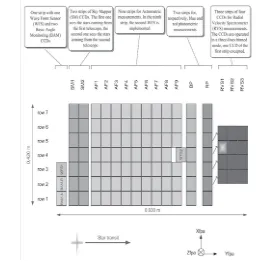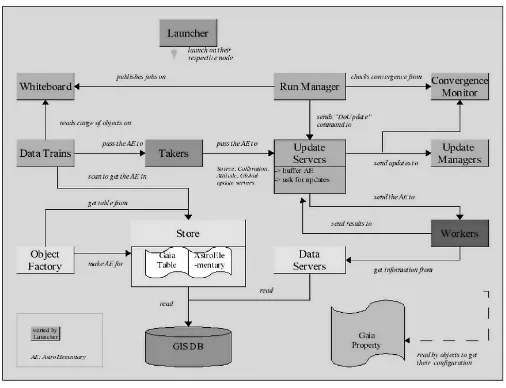Astronomical Data Analysis Software and Systems XIX ASP Conference Series, Vol. 434,!c 2010
Y. Mizumoto, K.-I. Morita, and M. Ohishi, eds.
Implementation of the Global Parameters Determination
in Gaia’s Astrometric Solution (AGIS)
Frederic Raison and Alfonso Olias
European Space Astronomy Centre of ESA, Madrid, Spain
David Hobbs and Lennart Lindegren
Lund Observatory, Lund, Sweden
Abstract. Gaia is ESA’s space astrometry mission with a foreseen launch date in early 2012. Its main objective is to perform a stellar census of the 1000 Million brightest objects in our galaxy (completeness to V=20 mag) from which an astrometric catalog of micro-arcsec level accuracy will be constructed. A key element in this endeavor is the Astrometric Global Iterative Solution (AGIS). A core part of AGIS is to determine the accurate spacecraft attitude, geometric instrument calibration and astrometric model parameters for a well-behaved subset of all the objects (the ‘primary stars’). In addition, a small number of global parameters will be estimated, one of these being PPN γ. We present here the implementation of the algorithms dedicated to the determination of the global parameters.
1 Motivation
The global parameters estimation provides a number of stringent tests of general relativity. Gaia is expected to constrain two parameters of the PPN formalism:
• PPNγ, measuring the curvature of space-time through gravitational light deflection.
• PPNβ, measuring the degree of non linearity in the superposition law of gravity.
Based on simulations (AGISLab), AGIS could provide a value of PPN γ about 10−6, which is significantly better than today’s best estimate from the Cassini mission (10−5).
2 Gaia Measurements
Gaia is a scanning satellite, hence stars transit through the focal plane contin-uously in the along-scan direction (see Fig. 1). CCDs are operated in Time-Delayed Integration (TDI) mode synchronized with the star motion on the focal plane. Due to the large amount of CCDs and the limited down link band-width, the amount of data to be gathered has been reduced by defining windows around the selected objects. Some 700 measurements per object of the time of observation are expected over the 5 year mission (1012
observations). The time of observation value for image centre relative to CCD is determined to ∼ 200
Global Parameters Determination in AGIS 387
Figure 1. Gaia Field Of View
mas precision (magnitude 15). These values are part of inputs in AGIS called AstroElementaries.
3 AGIS
AGIS is the mathematical and numerical scheme that will generate the core as-trometric solution, i.e. the standard asas-trometric parameters (position, parallax, proper motion, radial velocity) for all observed celestial objects brighter than G=20 mag with targeted accuracies (e.g. < 10 µas [G < 10 mag], < 25 µas [G= 15 mag],< 300µas [G= 20 mag]). The best match between all measure-ment data and an observational model involving the unknown source, attitude, calibration, and global parameters is sought in a least-square sense using normal equations and a block-iterative solution scheme. A Global Update block is used for global parameters determination.
4 Implementation
388 Raison et al.
Figure 2. AGIS implementation
4.1 Launcher
• runs on every node of the cluster. • starts the appropriate processes.
4.2 Run Manager
• controls the overall AGIS processing. • publishes jobs on the Whiteboard. • handles multiple iterations.
• checks for convergence of the solution by consulting the Convergence mon-itor.
4.3 Data Trains
• pick jobs from the Whiteboard.
• receive objects from the DB (AstroElementaries with times of observation). • pass the objects to the attached algorithms.
4.4 Algorithms
• Source Update, Attitude Update, Calibration Update, Global Update (op-tional).
• Client/Server scheme.
4.5 Taker
Global Parameters Determination in AGIS 389
4.6 Update Server
• buffers the list of AstroElementaries received from Collector. • processes them accumulating the update information.
4.7 (Global) Update Server
• passes the AstroElementaries to (Global) Update Worker (GlobalGIS). • one (Global) Update Server object is a master and the others are slaves. • Master will collect all the intermediate results from the slaves.
• Master will ask its (Global) Update Worker to perform the final
calcula-tion.
5 Algorithms for Global Update Block
Assuming a centered Gaussian observation noise of standard deviationσL the astrometric problem is equivalent to a weighted least-square minimization of
minxJ(x) =
This scheme performs a special treatment of outliers (involving the down-weighting function wL and the fraction " of data having a larger standard de-viation). The solution vector x = (g1, g2, ...., gn) gives the optimal agreement between the observational model f and the actual observations. What is really solved in practice is a system of normal equations system for the updates ∆x to the parameters x:
eters. In the case of PPNγ, the partial derivatives δRL δx i.e.
δRL
δγ are obtained
through a general relativity model (Gaia Relativistic Model) that provides a single consistent relativistic framework for the whole Gaia processing.
6 Preliminary Results
So far, the 10−5
level of accuracy was reached with:
• PPNγas first global parameter.
• the average parallax as a second parameter to reduce the impact of the
statistical correlation between PPNγand the parallax.
• 167×106AstroElementaries ( 2×106simulated sources). • Starting value: PPNγ= 1.1
• Simulated true value: PPNγ= 1.0
Improved implementation and a larger set of simulated observations should allow to reach the expected 10−6

